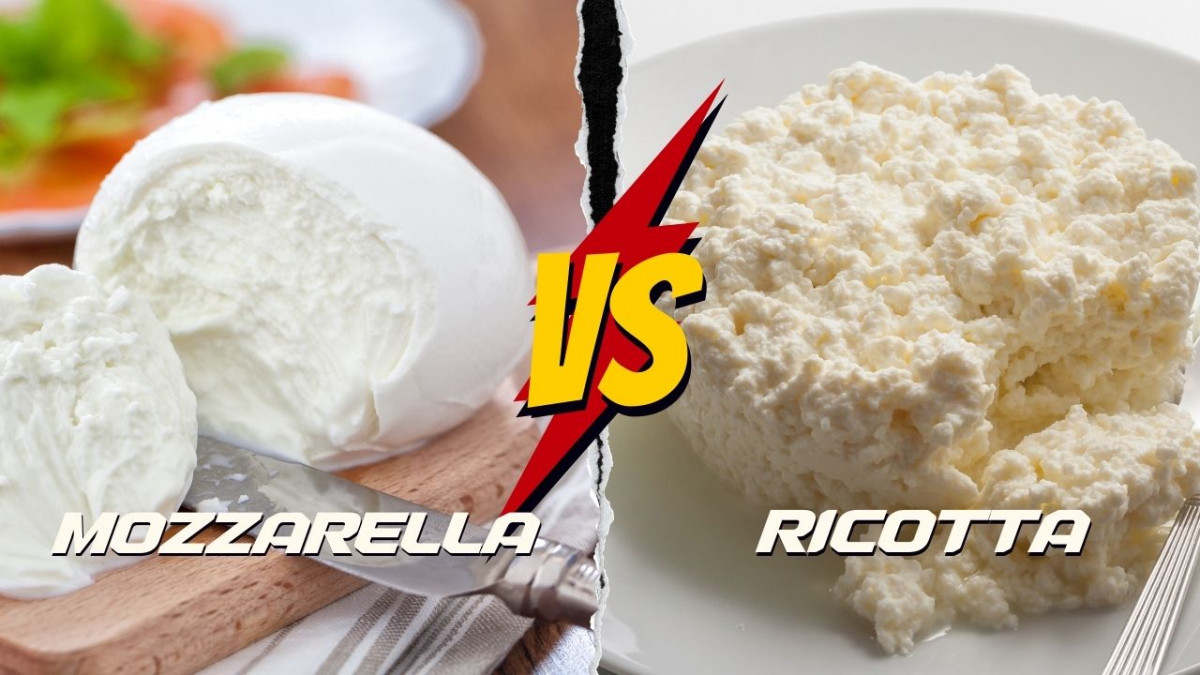Last Updated on January 17, 2024 by Aaron
Mozzarella and ricotta are widely used in Italian cooking and have become a staple of American cuisine. Mozzarella is a semi-soft cheese that has a creamy, mild flavor and is most commonly used on pizza or macaroni. It can also be enjoyed as part of an antipasto platter or made into potato croquettes.
Ricotta, on the other hand, is a mass of soft-grainy cheese with a mild and sweet flavor. It’s often found in Italian dishes such as lasagna, cannelloni and ravioli. It’s also a delicious topping for toast or crackers. Ricotta is also used to make desserts like cheesecake and cannoli.
Table of Contents
Mozzarella is fresh cheese; Ricotta is whey cheese.
Mozzarella and ricotta both have a mild and creamy taste. However, mozzarella is a fresh cheese made from cow or buffalo milk, while ricotta is a whey cheese made from the leftover whey liquid after cheese is made. It is a dairy byproduct extracted from the remaining whey to reduce wastage. Thus, ricotta is not technically considered a cheese.
Mozzarella is firmer and has a smooth elastic texture, while ricotta is much softer and grainier. Therefore when it comes to cooking, mozzarella tends to be the go-to cheese for pizzas, pastas and other Italian dishes due to its stretchy texture when melted. Ricotta, on the other hand, is more often used as a filling or topping for dishes.
Traditionally, both mozzarella and ricotta are best consumed freshly after being made, and have short shelf life. Though, they also have aged varieties available which are richer in flavor. Mozzarella does not age very long, usually for a couple of weeks. Ricotta forte is aged 12-18 months or more.
Mozzarella will melt; Ricotta cheese doesn’t melt.
When it comes to melting capabilities, mozzarella wins hands down. Mozzarella will melt and stretch nicely but not spread like cheddar cheese, read why. Ricotta cheese is acid-curdled cheese similar to paneer and halloumi and they all don’t melt well, or at all. Another reason is that ricotta is albumin cheese, which is made by coagulating albumin proteins and will have high heat resistance. Most other cheeses including mozzarella are casein proteins.
Mozzarella is stretched-curd cheese; Ricotta is acid-curdled cheese
The main difference between mozzarella and ricotta is the way they are made. Mozzarella can be made by acid-curdled easily at home, but rennet enzyme will usually be used in large scale production to give it the better stretchiness. Mozzarella is a stretched-curd (pasta filata) cheese, which means that the milk curds are added with hot water and then stretched and kneaded until it becomes smooth and stretchy. Lastly, the cheese is formed into shapes in cold water.
Ricotta, on the other hand, is an acid-curdled cheese made by adding natural acids such as vinegar or lemon juice to the leftover (cloudy) whey from the production of cheese — which can be any milk but mostly cow milk. Optionally, milk or cream can be added to the whey. The whey is then heated to near boiling and left to stand until the curds and whey separate. Curds are collected and the whey liquid which is then clearer is drained off. The yield is usually much lower than the ordinary cheese.
Which is Healthier?
Both mozzarella and ricotta are among the best healthy cheeses according to HealthLine. They both contain good nutritional values and are great for weight loss, with Mozzarella containing roughly 24% more fat and 38% more calories. Both cheeses are high in calcium, phosphorus, and protein. Ricotta is a lower-calorie option but it also tends to be saltier and higher in lactose than mozzarella. Since both types of cheese have a mild taste, they can be substituted for each other without affecting the flavor of a dish if the texture is not your main concern.

